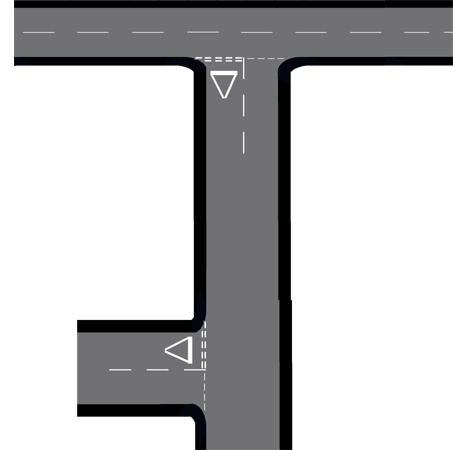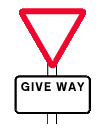Assess & Decide
Assess - if there is traffic approaching from the right you must not move out if in doing so you would cause anyone to change speed or direction, if there are any pedestrians crossing the road you are turning into - STOP and wait until it is clear to proceed safely.
Decide - If there is closely approaching traffic or pedestrians crossing your path then you must not emerge - DO NOT ALLOW THE FRONT OF YOUR CAR TO PASS THE GIVE WAY LINES UNTIL YOU KNOW IT IS SAFE.
Before you do emerge make your final mirror checks to ensure the situation behind has not altered, look particularly for cyclists on your left.
Once you can see clearly into the road that you are joining and you are sure that it is safe to emerge then you should consider which gear is appropriate, the correct gear will depend on the speed of your vehicle. If the car is still moving at about walking pace then 2nd gear will be correct - if you have had to stop or practically stop before that you could se if it was safe then you will need to select 1st gear.
In this example the driver has had an early uninterrupted view he has looked, assessed the situation and because there is no need to give way and the there are no road markings requiring him to stop can begin to make his turn.
Let's look at this vehicle which intends to turn left at the T junction ahead.
Remember the first thing we'll be doing is checking the Mirrors
Manoeuvre.
Position. The first part of the manoeuvre is to take up the correct position. The position for a left turn when emerging is the same as when you are approaching to make a left turn - can you remember what the correct position is?
The correct position for turning left is the normal driving position - about 1m (the width of an open car door) from the kerb.
The driver in our example is using his nearside mirror to check his distance from the kerb and will have noted that there are no obstructions to the front that prevent him maintaining his normal position.
Now we're ready to adjust our speed for a safe approach and prepare for any gear change that we might need to make.
Speed
When you are driving towards a T junction your speed and observations are closely related.
You should reduce your speed as if you were intending to stop at the junction - you might have to! If you do have to stop you should remember not to push the clutch in too soon (this will cause you to coast and affect your speed).
The purpose of slowing down is to give you time to take effective observations, this means looking both ways, at least right, left and right again when you reach a point from which you can see clearly in both directions you will be able to act sensibly according to the situation.
In this situation you will notice that the driver has a clear view in both directions from a position well back from the junction - he will still be moving at a speed that will allow him to stop if necessary but will already be planning to make the turn if the situation does not change.
But it's important to remember that the situation can change very quickly and we need to be ready to deal with the unexpected. To be able to deal with anything that might happen we need to be looking for potential problems as soon as we can.
Once you have reached a position which allows you a clear uninterrupted view in both directions you will be able to see if it is safe to proceed - you need to go through the thought process of :
Look - Assess - Decide.
Look - can you remember what you should be looking for?
What are we looking for? 
We'll be looking for traffic approaching from either direction, looking into the new road for any pedestrians who may be crossing the road meaning we must give way, and making a final check in our mirrors to see what is happening behind - in particular checking the exterior mirror for any cyclists or motor cyclists coming up on our left.
Signal
Signals must be given in good time but we need to ensure they will not be confusing to others.
In this case the driver has delayed his signal, if we applied the signal earlier the driver of the blue car might believe we intend turning left into the junction he is waiting to emerge from.
If there had been any vehicles parked at the roadside we would also have delayed our signal until we had adjusted our position to pass the stationary vehicle - any following drivers would then have no misunderstanding of our intentions.
Is there anything else that an alert driver will have noticed at this point
There is a give way sign at the left of the road.
This would give us warning of the junction ahead if we were not already aware of it, and it will help in our planning as we move towards the hazard.
The driver delays his signal until he is sure there will be no confusion and then he'll be ready for the manoeuvre phase.
 Emerging at Junctions
Emerging at Junctions 



